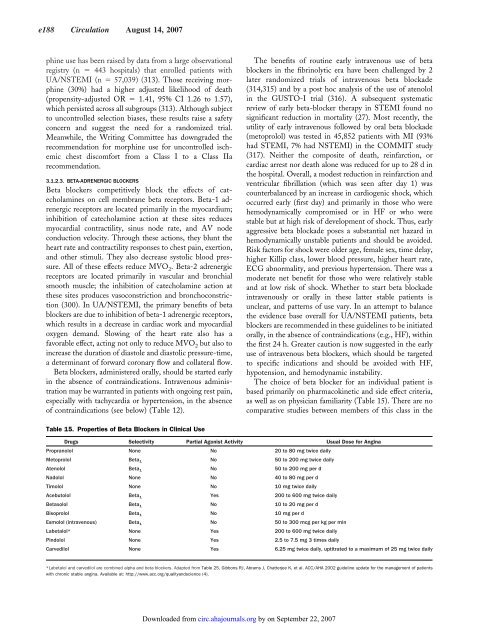ACC/AHA 2007 guideline update for the
ACC/AHA 2007 guideline update for the
ACC/AHA 2007 guideline update for the
Create successful ePaper yourself
Turn your PDF publications into a flip-book with our unique Google optimized e-Paper software.
e188 Circulation August 14, <strong>2007</strong><br />
phine use has been raised by data from a large observational<br />
registry (n 443 hospitals) that enrolled patients with<br />
UA/NSTEMI (n 57,039) (313). Those receiving morphine<br />
(30%) had a higher adjusted likelihood of death<br />
(propensity-adjusted OR 1.41, 95% CI 1.26 to 1.57),<br />
which persisted across all subgroups (313). Although subject<br />
to uncontrolled selection biases, <strong>the</strong>se results raise a safety<br />
concern and suggest <strong>the</strong> need <strong>for</strong> a randomized trial.<br />
Meanwhile, <strong>the</strong> Writing Committee has downgraded <strong>the</strong><br />
recommendation <strong>for</strong> morphine use <strong>for</strong> uncontrolled ischemic<br />
chest discom<strong>for</strong>t from a Class I to a Class IIa<br />
recommendation.<br />
3.1.2.3. BETA-ADRENERGIC BLOCKERS<br />
Beta blockers competitively block <strong>the</strong> effects of catecholamines<br />
on cell membrane beta receptors. Beta-1 adrenergic<br />
receptors are located primarily in <strong>the</strong> myocardium;<br />
inhibition of catecholamine action at <strong>the</strong>se sites reduces<br />
myocardial contractility, sinus node rate, and AV node<br />
conduction velocity. Through <strong>the</strong>se actions, <strong>the</strong>y blunt <strong>the</strong><br />
heart rate and contractility responses to chest pain, exertion,<br />
and o<strong>the</strong>r stimuli. They also decrease systolic blood pressure.<br />
All of <strong>the</strong>se effects reduce MVO 2. Beta-2 adrenergic<br />
receptors are located primarily in vascular and bronchial<br />
smooth muscle; <strong>the</strong> inhibition of catecholamine action at<br />
<strong>the</strong>se sites produces vasoconstriction and bronchoconstriction<br />
(300). In UA/NSTEMI, <strong>the</strong> primary benefits of beta<br />
blockers are due to inhibition of beta-1 adrenergic receptors,<br />
which results in a decrease in cardiac work and myocardial<br />
oxygen demand. Slowing of <strong>the</strong> heart rate also has a<br />
favorable effect, acting not only to reduce MVO 2 but also to<br />
increase <strong>the</strong> duration of diastole and diastolic pressure-time,<br />
a determinant of <strong>for</strong>ward coronary flow and collateral flow.<br />
Beta blockers, administered orally, should be started early<br />
in <strong>the</strong> absence of contraindications. Intravenous administration<br />
may be warranted in patients with ongoing rest pain,<br />
especially with tachycardia or hypertension, in <strong>the</strong> absence<br />
of contraindications (see below) (Table 12).<br />
Table 15. Properties of Beta Blockers in Clinical Use<br />
The benefits of routine early intravenous use of beta<br />
blockers in <strong>the</strong> fibrinolytic era have been challenged by 2<br />
later randomized trials of intravenous beta blockade<br />
(314,315) and by a post hoc analysis of <strong>the</strong> use of atenolol<br />
in <strong>the</strong> GUSTO-I trial (316). A subsequent systematic<br />
review of early beta-blocker <strong>the</strong>rapy in STEMI found no<br />
significant reduction in mortality (27). Most recently, <strong>the</strong><br />
utility of early intravenous followed by oral beta blockade<br />
(metoprolol) was tested in 45,852 patients with MI (93%<br />
had STEMI, 7% had NSTEMI) in <strong>the</strong> COMMIT study<br />
(317). Nei<strong>the</strong>r <strong>the</strong> composite of death, reinfarction, or<br />
cardiac arrest nor death alone was reduced <strong>for</strong> up to 28 d in<br />
<strong>the</strong> hospital. Overall, a modest reduction in reinfarction and<br />
ventricular fibrillation (which was seen after day 1) was<br />
counterbalanced by an increase in cardiogenic shock, which<br />
occurred early (first day) and primarily in those who were<br />
hemodynamically compromised or in HF or who were<br />
stable but at high risk of development of shock. Thus, early<br />
aggressive beta blockade poses a substantial net hazard in<br />
hemodynamically unstable patients and should be avoided.<br />
Risk factors <strong>for</strong> shock were older age, female sex, time delay,<br />
higher Killip class, lower blood pressure, higher heart rate,<br />
ECG abnormality, and previous hypertension. There was a<br />
moderate net benefit <strong>for</strong> those who were relatively stable<br />
and at low risk of shock. Whe<strong>the</strong>r to start beta blockade<br />
intravenously or orally in <strong>the</strong>se latter stable patients is<br />
unclear, and patterns of use vary. In an attempt to balance<br />
<strong>the</strong> evidence base overall <strong>for</strong> UA/NSTEMI patients, beta<br />
blockers are recommended in <strong>the</strong>se <strong>guideline</strong>s to be initiated<br />
orally, in <strong>the</strong> absence of contraindications (e.g., HF), within<br />
<strong>the</strong> first 24 h. Greater caution is now suggested in <strong>the</strong> early<br />
use of intravenous beta blockers, which should be targeted<br />
to specific indications and should be avoided with HF,<br />
hypotension, and hemodynamic instability.<br />
The choice of beta blocker <strong>for</strong> an individual patient is<br />
based primarily on pharmacokinetic and side effect criteria,<br />
as well as on physician familiarity (Table 15). There are no<br />
comparative studies between members of this class in <strong>the</strong><br />
Drugs Selectivity Partial Agonist Activity Usual Dose <strong>for</strong> Angina<br />
Propranolol None No 20 to 80 mg twice daily<br />
Metoprolol Beta1 No 50 to 200 mg twice daily<br />
Atenolol Beta1 No 50 to 200 mg per d<br />
Nadolol None No 40 to 80 mg per d<br />
Timolol None No 10 mg twice daily<br />
Acebutolol Beta1 Yes 200 to 600 mg twice daily<br />
Betaxolol Beta1 No 10 to 20 mg per d<br />
Bisoprolol Beta1 No 10 mg per d<br />
Esmolol (intravenous) Beta1 No 50 to 300 mcg per kg per min<br />
Labetalol* None Yes 200 to 600 mg twice daily<br />
Pindolol None Yes 2.5 to 7.5 mg 3 times daily<br />
Carvedilol None Yes 6.25 mg twice daily, uptitrated to a maximum of 25 mg twice daily<br />
*Labetalol and carvedilol are combined alpha and beta blockers. Adapted from Table 25, Gibbons RJ, Abrams J, Chatterjee K, et al. <strong>ACC</strong>/<strong>AHA</strong> 2002 <strong>guideline</strong> <strong>update</strong> <strong>for</strong> <strong>the</strong> management of patients<br />
with chronic stable angina. Available at: http://www.acc.org/qualityandscience (4).<br />
Downloaded from<br />
circ.ahajournals.org by on September 22, <strong>2007</strong>
















